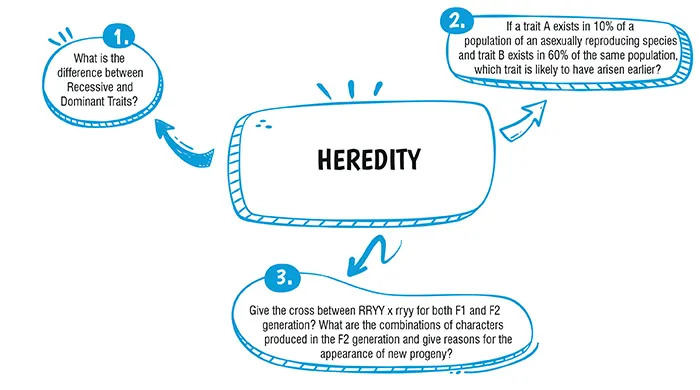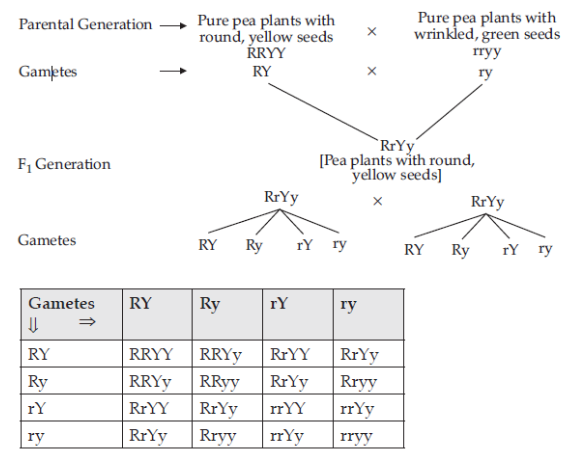Table of Contents

Ans. (a)
Explanation:
The cross between RRyy (round, green) and rrYY (wrinkled, yellow) seeds will produce RrYy (round and yellow) seeds in F_1, generation, because round and yellow are dominant traits
Ans. (b)
Explanation:
Gene is a particular sequence of DNA, that codes for a particular protein and is present on a particular location on a given chromosome. Genes are located on chromosomes, which usually carry many genes. All the members of a species have the same (not identical) genes located on the same chromosome. Thus, gene sequence remains the same on the chromosomes in different individuals of a species.
Explanation:
| Dominant Trait | Recessive Trait |
|---|---|
| Dominant traits are always expressed when the connected allele is dominant, even if only one copy exists. | Recessive traits are expressed only if both the connected alleles are recessive. If one of the alleles is dominant, then the associated characteristic is less likely to manifest. |
| Dominant allele is denoted by a capital letter. | Recessive allele is denoted by a small letter. |
Explanation:
Trait B is likely to have arisen earlier than trait A. In asexually reproducing species, genetic variations arise from small mutations or inaccuracies in DNA replication. Traits that are present in a higher percentage of the population are generally older because they have had more time to spread and become established within the population. Trait B, existing in 60% of the population, suggests it is more widespread and likely has been present for a longer period. Trait A, existing in only 10% of the population, is less common and likely more recent. Therefore, trait B is likely to have arisen earlier and had more time to proliferate in the population.
Explanation:

Reason for Appearance of New Progeny: The new combinations of traits in the F_2 generation result from the independent assortment of genes during meiosis in the F_1 plants. This process allows for different combinations of dominant and recessive alleles to occur, leading to new phenotypic combinations in the progeny. This phenomenon, known as genetic recombination, is a key feature of Mendelian inheritance and contributes to genetic diversity.
| Chapter No. | Chapter Name |
|---|---|
| Chapter 1 | Chemical Reactions and Equations |
| Chapter 2 | Acid, Bases and Salts |
| Chapter 3 | Metals and Non-Metals |
| Chapter 4 | Carbon and its Compounds |
| Chapter 5 | Life Processes |
| Chapter 6 | Control and Coordination |
| Chapter 7 | How do Organisms Reproduce |
| Chapter 8 | Heredity |
| Chapter 9 | Light : Reflection and Refraction |
| Chapter 10 | The Human Eye and the Colourful world |
| Chapter 11 | Electricity |
| Chapter 12 | Magnetic Effects of Electric Current |
| Chapter 13 | Our Environment |
| Chapter Wise Important Questions for CBSE Board Class 10 Science |
|---|
| Chemical Reactions and Equations |
| Acid, Bases and Salts |
| Metals and Non-Metals |
| Carbon and its Compounds |
| Life Processes |
| Control and Coordination |
| How do Organisms Reproduce |
| Heredity |
| Light : Reflection and Refraction |
| The Human Eye and the Colourful world |
| Electricity |
| Magnetic Effects of Electric Current |
| Our Environment |
CBSE Important Questions Class 10
ICSE Important Questions Class 10
CBSE Important Questions Class 10
ICSE Important Questions Class 10